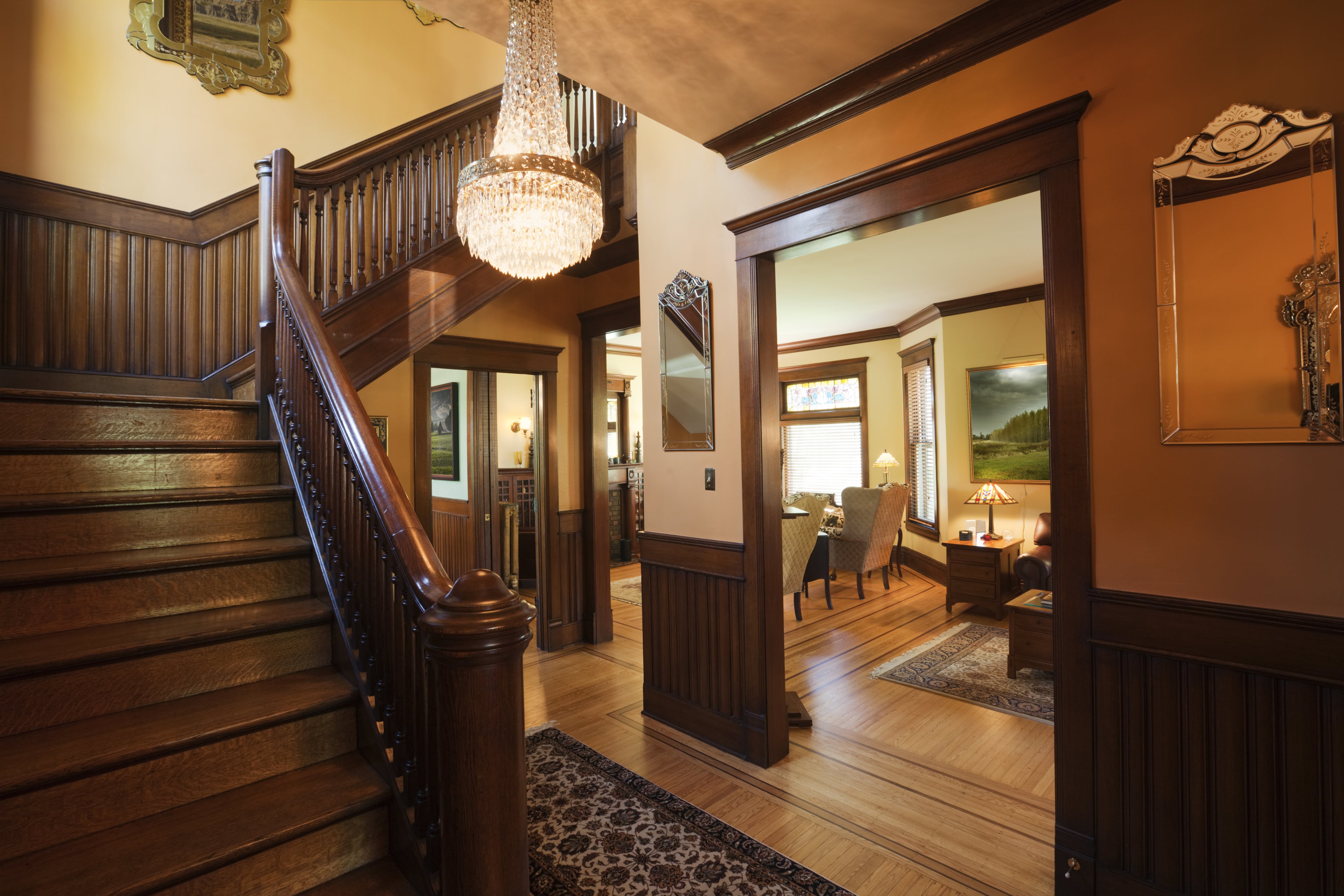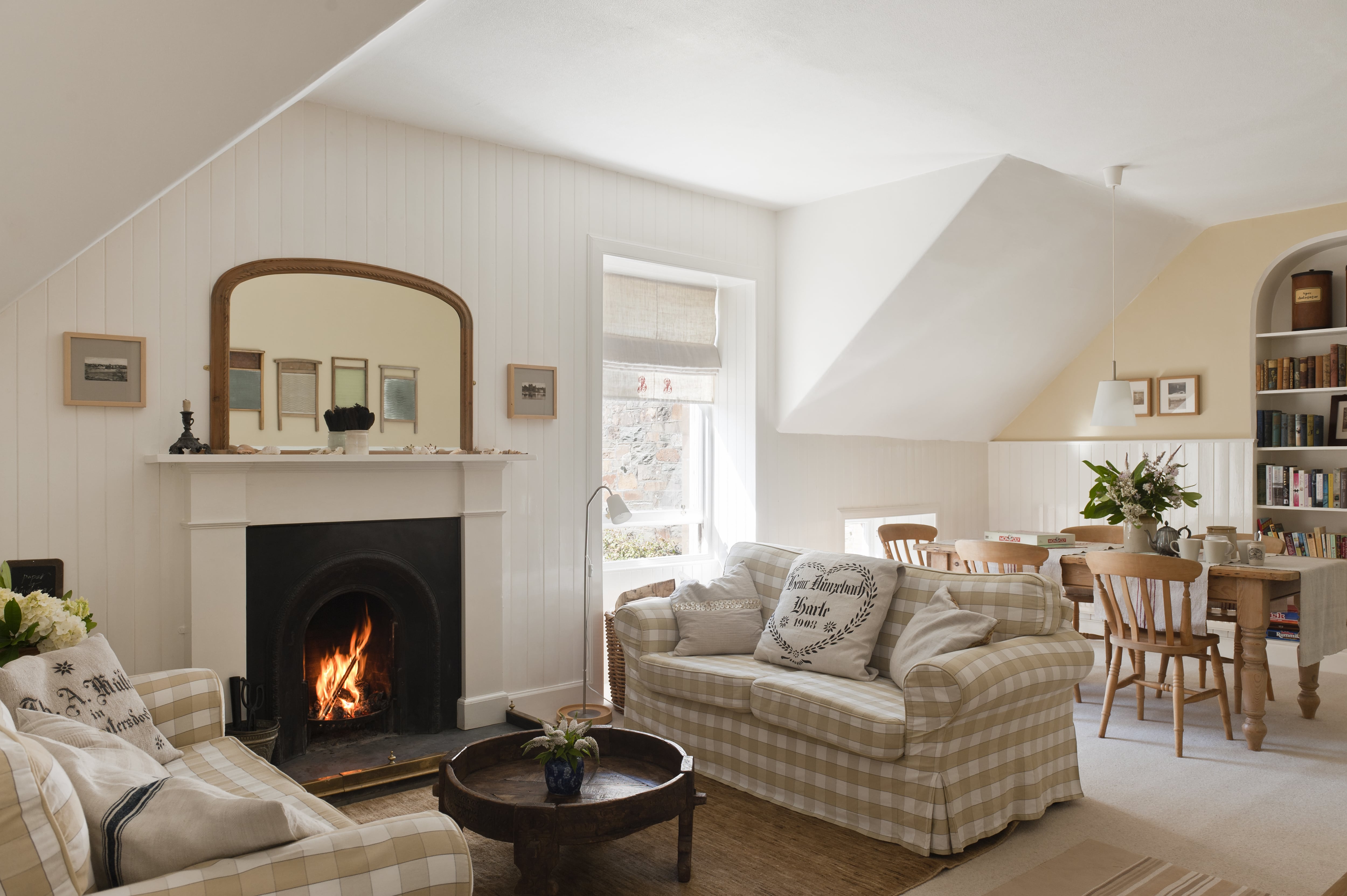15 Charming Wainscoting Ideas for Every Room in Your Home
If walls could talk, they’d ask for wainscoting


Maybe you’re tired of the dogs and the kids leaving their literal mark all over the walls of your home. Maybe you’re looking to add an air of elegance around your house but can’t pinpoint exactly how to get it. Wainscoting—wood paneling added to the lower third of a wall to help protect it and enhance its looks—is the solution to both problems. So we’ve rounded up wainscoting ideas for every room to show you how you can transform your home with it.
Entryway and Stairwell Wainscoting Ideas
The main entryway of your home is where visitors get the first glimpse of your style and is an area that gets arguably the most foot traffic. Adding wainscoting to this area is a great way to protect the walls from wet-weather gear left to drip dry or stampedes of backpack-toting children while showing off the uniqueness of your abode as soon as you open the front door.
1. Go with the Flow

If the entryway to your home opens up into additional rooms, consider continuing a raised paneling style wainscoting along the walls and corridors to create a graceful flow from room to room.
2. Dazzle with Dramatic Colors

Prefer a more luxurious look? If you own a Victorian-style home, opt for a rich, dramatic wall paint color and mahogany wainscoting. This darker aesthetic achieves a cozy, yet regal appearance that will leave your guests in awe. Continuing the dark wood wainscoting along the walls leading up the stairwell encourages a sense of intrigue for what the second floor has to offer.
Foyer and Mudroom Wainscoting Ideas
Whether you’re just getting home from traveling abroad or a trip to the local market, the luggage or grocery bags you’ve got in tow have a pesky way of banging up against the walls of the first room you walk through. Fear not, because wainscoting could be the additional armor your walls need to stay scuff-free.
3. Highlight the Details

Similar to the decor of the primary entryway, the interior décor of the foyer can speak volumes about the rest of the house. Put your home’s extravagance on display by adding intricate designs to the wainscoting, and have it placed not only along the walls but also around doorways.
4. Take the Mud Out of Mudroom

It’s all in the name—the idea of a mudroom is to contain the mud. The walls of your mudroom are the most vulnerable to scuffs, stains, and other undesirable damages. Add a beadboard-style wainscoting in the midsection of the wall to guard it against dirty shoes and sticky fingers. Mid-wall installation allows for additional shelves and cabinet space above and below the paneling.
Family Room and Den Wainscoting Ideas
Whether it’s for a chaotic game night or to settle in with a movie, the family room is where the whole family comes to gather. No matter the mood or the agenda, create a space for everyone to come together within that achieves comfort and character.
5. Elevate the Simplicity

You don’t have to dedicate every wall to wainscoting, start slow by adding a board and batten wainscoting accent wall, or try adding some abstract-shaped cutouts to a section of a wall, and watch as it evokes a subtle artistic element to an otherwise simplistic white room.
6. Go Big or Go Small

Mix and match by installing full-length vertical wainscoting on one wall, then cutting it down in size on the next for an alternating aesthetic. This approach is helpful in rooms with ceilings that fluctuate in size and shape, and offers a fresh, flowing look.
Kitchen Wainscoting Ideas
The kitchen is the family room’s fiercest competitor in the battle of which room gets occupied the most. Whether you’re hosting your extended family for the holidays or starting the day off with a quiet breakfast, do it in a room that wows—and not just because of the food.
7. Extend Your Expectations

If you have limited kitchen space, installing wainscoting can surprisingly help combat this. Choosing a color for the wainscoting that contrasts against the wall paint color can help create the illusion of a bigger room. When the wall color in a small room is the same throughout, it can close off the area in a, “what you see is what you get” fashion. Try installing wainscoting over three-fourths of the wall, and watch how the walls suddenly appear taller.
8. Give Your Island a Makeover

Prefer to stray from the norm? Elevate your kitchen island with wainscoting instead of the walls. After all, an island tends to be the focal point of the kitchen anyway, so give it a little wainscoting TLC, and let it be the star of the show.
Dining Room Wainscoting Ideas
No matter if your dining room is formal or casual, there’s a wainscoting option for it. Customize yours in height and color, and the conversation at the table will never revolve around dinner again.
9. Dress Up Your Walls

Are you a lover of wallpaper and wainscoting? You really can have it all. A traditional white wainscoting can be the perfect complement to your favorite patterned wallpaper.
10. Revive The Renaissance

Create a dining room fit for a castle with this 360-degree dark wood wainscoting design. The other rooms in your house will have a hard time competing with the majestic atmosphere that this look exudes.
Bedroom Wainscoting Ideas
Maybe you’re past the days of hanging posters on them, but your bedroom walls can still showcase your personality if you give them a little flair.
11. Take the Beach with You

Whether it’s your personal suite or a guest bedroom, let the peace and relaxation flow freely. Pairing an eggshell-colored beadboard wainscoting with a light blue wall can give any landlocked room a beachfront vibe.
12. Build an Oasis for Creativity

No one said wainscoting couldn’t be bright and exciting. Kick things up a notch by adding a floor-to-ceiling board and batten wall in a vibrant color, like this shade of kelly green. You’ll feel bold and inspired every time you enter this colorful paradise—the perfect environment to get creative in.
13. Bring the City to the Suburbs

Speaking of color options, gray and black deserve a shout out too. Pairing a jet black board and batten accent wall with a dark gray wall with wainscoting will create such an ultra-modern and sleek look you’ll be transported to the city without ever leaving the suburbs.
Bathroom Wainscoting
The bathroom should be a place where you can get a moment of peace, whether you’re on the go or moving slow. Transform yours into a comfortable haven no matter the size of it.
14. Maximize Your Space

If your bathroom is on the smaller side, consider using slender panels of wood or beadboard to create a shiplap bathroom and give your commode a comforting look.
15. Go the Extra Mile with Tile

If wood in the bathroom doesn’t sound like a match made in heaven to you, break up the walls with a wainscoting tile instead. Not only does it offer a glossy sheen, but it makes for an easier cleaning experience.
Is Wainscoting Outdated?
Despite originating in the 18th century, when it was primarily used to insulate and protect walls against scuff marks and scratches from things like hard chair backs bashing into them, wainscoting is surprisingly not outdated. In fact, it can be found today in everything from colonial to contemporary homes.
How Does Wainscoting Protect Walls?
Walls tend to get dinged up fairly easily, as any homeowner who has ever patched a scratch or a hole can tell you. Wainscoting overlays a hard protective layer on top of the walls to fend off these dents.
Though the original material used for wainscoting was wood, nowadays it can be built out of plastic, plywood, or medium-density fiberboard (MDF), among other materials. These hard shells tend to need only a fresh coat of paint to revive them if they do get banged up, versus the smear of joint compound often needed to patch drywall.
What Rooms Should Have Wainscoting?
While wainscoting could be a welcomed addition to every room, it comes down to personal preference. If you love the aesthetic, make wainscoting a staple for your walls. Or, start slow and install it on the walls in the rooms you think are most susceptible to surface-level damage.
As soon as you’re ready to upgrade, consider contacting a local pro to get an estimate today.





- What Is the Right Bathroom Wainscoting Height?
- The 6 Best Types of Wainscoting for Your Home
- 22 Wall Covering Ideas to Add Interest to Your Rooms
- 18 Stylish Wall Paneling Ideas
- Beadboard Paneling Is a ‘Groove’-y Way to Add Charm to Your Home
- 6 Common Molding Types Found in Homes
- Home Staging Checklist: 35 Tips to Sell Your Home Quickly
- 40 Budget-Friendly Small Bathroom Ideas to Spruce Up Your Space
- How to Choose the Best Wall Color for Your Open Floor Plan
- 11 Home Addition Ideas to Personalize Your Space










